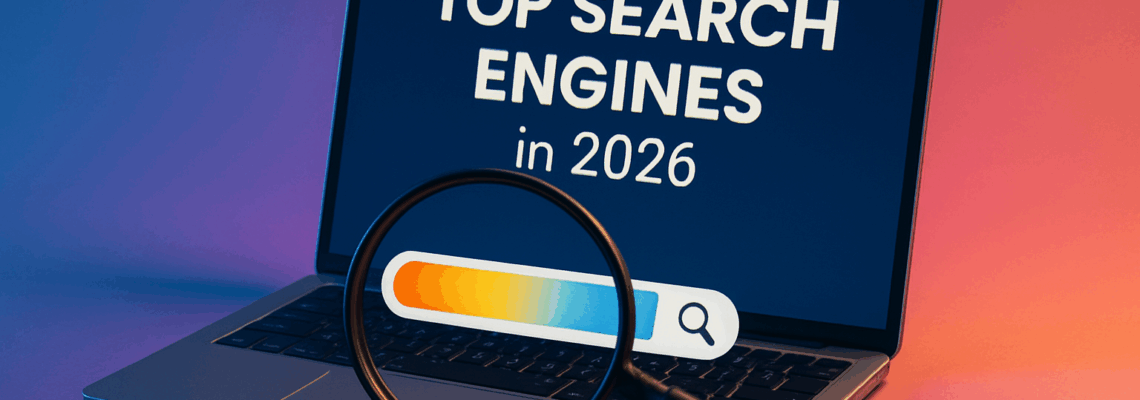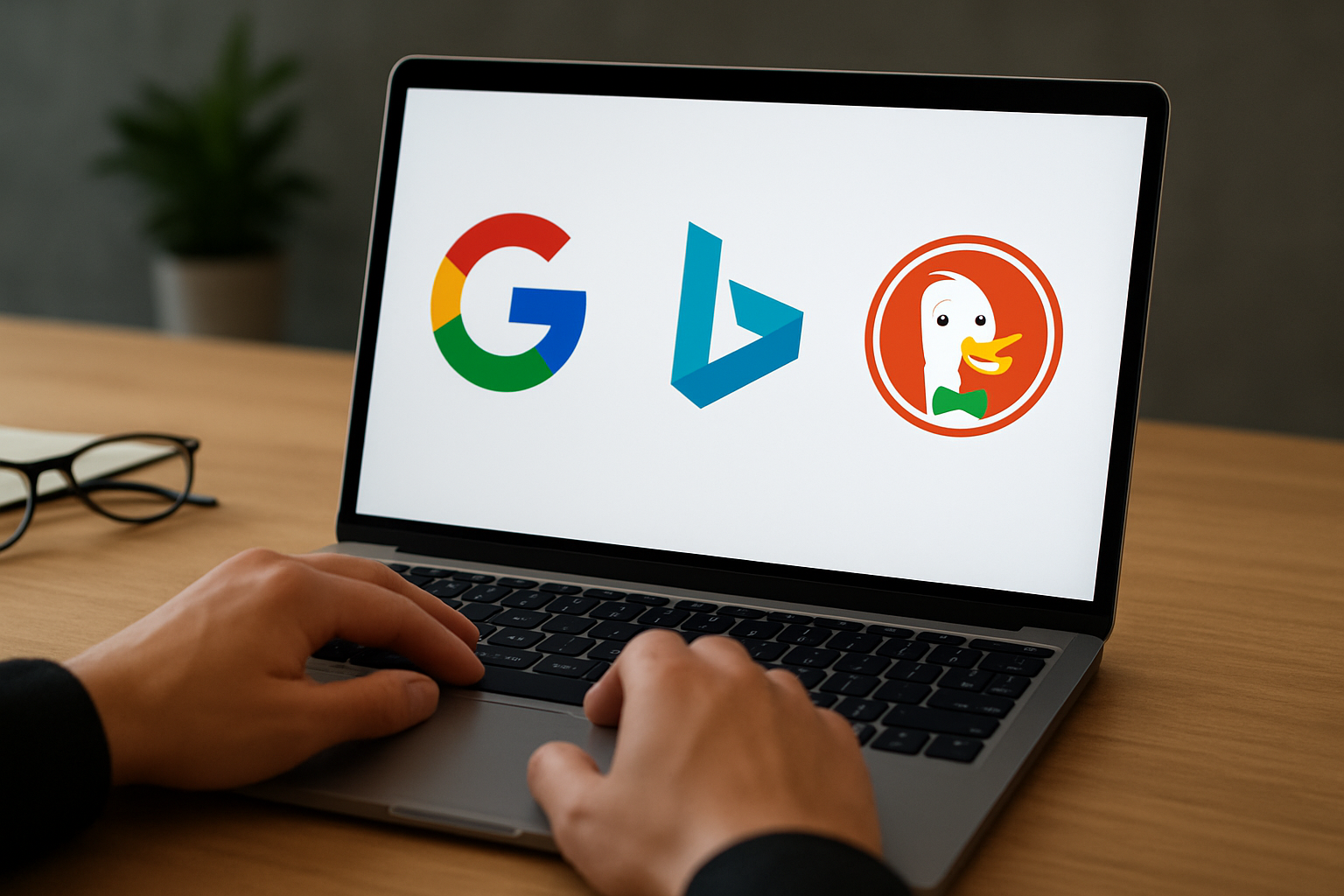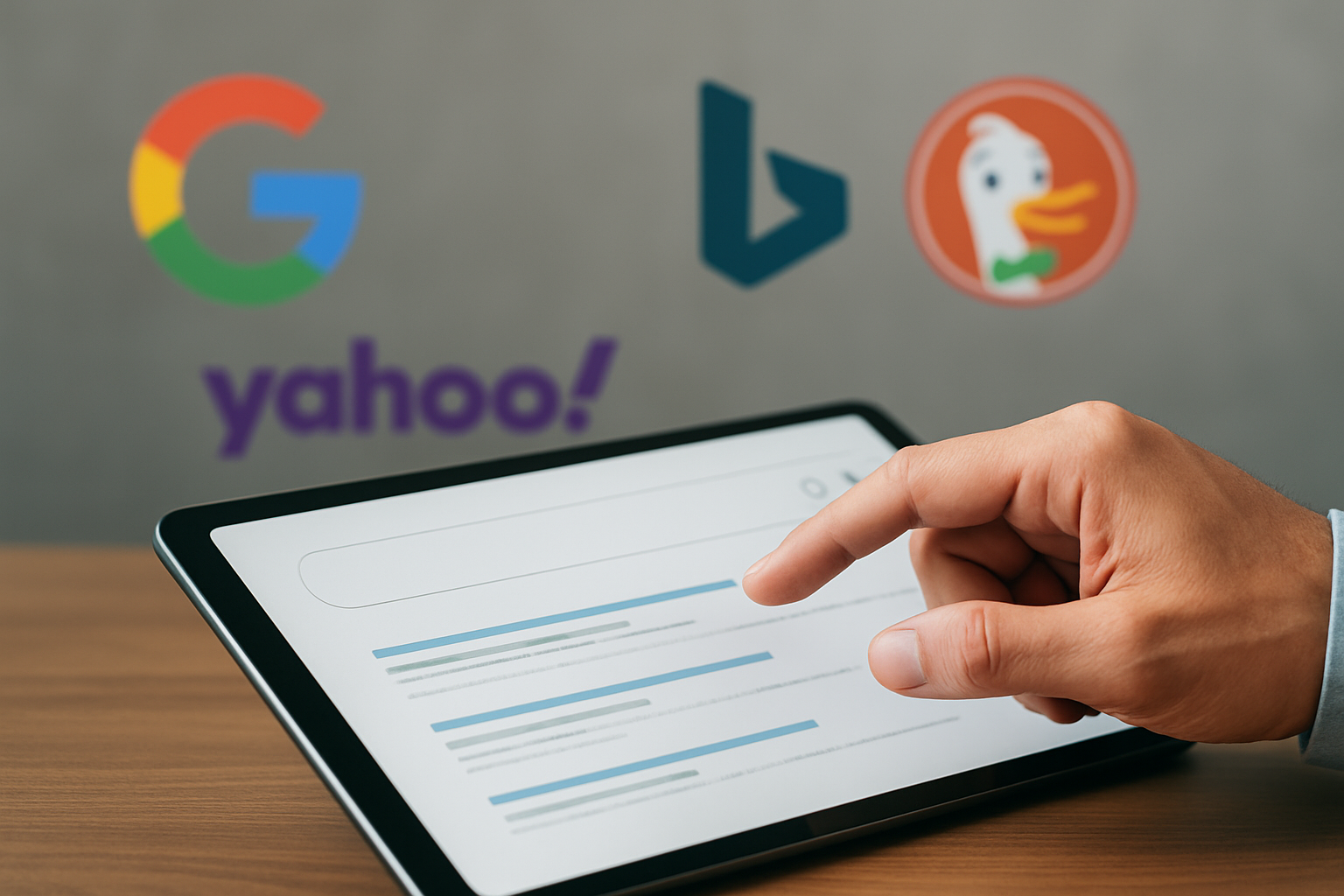Top Search Engines for Businesses in 2026: Market Share, User Intent & Where to Invest Your SEO and PPC Budget
If you had to place your 2026 bets on the top search engines today, where would you put your chips and why? Here is the short answer: it depends on your market, your buyer’s intent, and how quickly you need outcomes. The long answer is more interesting, because search is no longer just ten blue links. It is a living ecosystem of engines, assistants, surfaces, and vertical marketplaces that shape what your customers see first.
Before we dive in, a quick framing thought. Google still dominates, but your audience is fragmenting into video, maps, shopping, and privacy-first search experiences. That means smart companies act like portfolio managers. You allocate organic and paid dollars across engines based on risk, return, and reach, then rebalance quarterly as algorithms and features shift.
At Internetzone I, we help companies of all sizes make these calls with confidence. Our team blends National & Local SEO (Search Engine Optimization), AdWords (Google Ads) Certified PPC (Pay-Per-Click) Services, web design that is mobile responsive and SEO-focused, eCommerce solutions, reputation management, and managed web services. In this listicle, you will get data-backed insights, a practical budget blueprint, and a playbook you can hand to your team this week.
The Top Search Engines at a Glance in 2026
Let us ground the conversation in market reality. Google remains the gravitational center of the open web, but there are engines and search surfaces where your next customer may begin. The table below combines trailing 12-month trends from widely cited sources like Statcounter Global Stats and Similarweb with business-friendly notes. Treat the percentages as directional ranges, then validate them for your niche and region during planning.
| Engine/Surface | Global Share or Volume | United States Share | Notable Audiences | Paid Options |
|---|---|---|---|---|
| ~90 to 92 percent | ~88 to 90 percent | General consumer and business, all intents | Google Ads Search, Performance Max, Shopping | |
| Bing | ~3 to 4 percent | ~6 to 8 percent | Desktop-heavy, corporate users, higher incomes | Microsoft Advertising Search, Shopping |
| Yahoo | ~1 to 2 percent | ~1 to 2 percent | News-focused, older demographics | Microsoft Advertising network |
| DuckDuckGo | ~0.5 to 1 percent | ~1 to 2 percent | Privacy-first searchers | Contextual ads via Microsoft Advertising |
| YouTube | Very high internal search volume | Very high internal search volume | How-to, reviews, entertainment, B2B research | YouTube Ads, Shorts Ads |
| Amazon | Dominant in product search | Dominant in product search | High-intent shoppers | Amazon Sponsored Products, Brands, Display |
| Baidu | ~1 to 3 percent globally, leading in China | Minimal | China market, Mandarin-first | Baidu Ads |
| Yandex | ~0.5 to 1.5 percent globally, strong in Russia | Minimal | Russia and neighboring regions | Yandex Direct |
| Naver | Strong in South Korea | Minimal | South Korea, portal-style search | Naver Ads |
| Apple Ecosystem Search | Large discovery surface via Siri, Spotlight, Maps | Large | iPhone and Mac users, local intent | Apple Search Ads for Apps, Maps visibility |
Two takeaways pop. First, despite the headliner dominance, there is leverage beyond Google for video, commerce, and privacy mindsets. Second, local visibility is increasingly shaped by maps, knowledge panels, and zero-click answers. If you are only measuring blue-link traffic, you are missing the story. This is why Internetzone I integrates web design, structured data, and reputation management into every National & Local SEO (Search Engine Optimization) plan.
The 10 Top Search Engines for Businesses in 2026
Which engines deserve a line on your 2026 plan? Here is a practical, business-first rundown you can actually act on. Think of this like a diversified portfolio across awareness, consideration, and conversion assets, not a popularity contest.
Watch This Helpful Video
To help you better understand top search engines, we’ve included this informative video from Brett In Tech. It provides valuable insights and visual demonstrations that complement the written content.
-
Google
Still the default for most queries and the most sophisticated at interpreting intent. Expect more AI (Artificial Intelligence) answers and shopping integrations, which means content quality and first-party data matter even more. For paid, Google Ads offers unmatched reach, but watch Cost Per Click trends by niche.
- Best for: Broad organic growth, local discovery, and competitive paid search.
- Wins with: Strong content hubs, technical health, fast pages, rich snippets, reviews.
- Tip: Track impression share and organic pixel ownership, not just Click-Through Rate (CTR) to account for zero-click results.
-
YouTube
YouTube is the internet’s video library and a gigantic search engine in its own right. For how-to, product research, and expert-led education, it outruns text. Your play is topic clusters that pair articles with videos, then retarget watchers with ads.
- Best for: Thought leadership, tutorials, product demos, testimonials.
- Wins with: Keyword-rich titles, tight hooks in the first 10 seconds, chapters, captions.
- Tip: Repurpose webinar clips into Shorts to reach incremental audiences cheaply.
-
Bing
Bing over-indexes on desktop, enterprise, and older demographics. With Copilot experiences layered into Microsoft products, it quietly converts well for B2B (Business to Business). CPC (Cost Per Click) is often lower than Google, making it a profitable second channel.
- Best for: B2B (Business to Business), white-collar services, higher-income suburbs.
- Wins with: Importing proven Google campaigns, then refining by device and schedule.
- Tip: Sync Bing Places and keep hours, categories, and photos accurate for local queries.
-
Apple Ecosystem Search
Customers search through Siri, Spotlight, and Apple Maps every day. You do not buy ads to rank in Maps, but you can earn visibility with Apple Business Connect, consistent listings, fresh reviews, and on-page clarity. For app developers, Apple Search Ads is a must-have.
- Best for: Local storefronts, service areas, restaurants, healthcare, apps.
- Wins with: Complete Apple Business Connect profiles, credible ratings, photos, and accessibility notes.
- Tip: Audit how your name, address, and phone appear across directories to avoid duplicates.
-
Amazon
Half of shoppers in the United States begin product search on Amazon. Compete here with optimized product pages, A+ content, reviews, and Sponsored Products. Treat Amazon like a pay-to-play shelf where conversion rate and availability rule.
- Best for: CPG (Consumer Packaged Goods), electronics, home goods, books.
- Wins with: Clear images, keyword-rich bullets, coupons, fast shipping, bundled variations.
- Tip: Use Amazon Posts and Brand Store to tell your story and defend against competitors.
-
Yahoo
Powered largely by Microsoft’s ad stack, Yahoo brings incremental reach with a news-forward crowd. It is rarely your first channel, but it can lower blended CPA (Cost Per Acquisition) when layered with Bing for brand defense and competitor terms.
- Best for: Budget expansion after Bing success.
- Wins with: Tight match types and negatives to prevent news click bleed.
- Tip: Monitor placement reports to keep quality high.
-
DuckDuckGo
Privacy-first searchers use DuckDuckGo because they do not want to be tracked across the web. That means contextual ad targeting and simple, relevant landing pages. It is small but valuable for brands that want to be seen as privacy-respecting.
- Best for: Security, finance, healthcare, and brand-conscious audiences.
- Wins with: Plain-language pages, no aggressive pop-ups, and clear policies.
- Tip: Use Microsoft Advertising to reach this audience without heavy lift.
-
Baidu
If China is in scope, Baidu is your starting line. Local hosting, language-native content, and regulatory compliance are not optional. Expect to invest in a localized site, Chinese social presence, and Baidu Ads for real traction.
- Best for: Brands with Chinese-language support and distribution.
- Wins with: Local domains, Simplified Chinese copy, fast hosting in-region.
- Tip: Budget for translation and moderation, not just ads.
-
Yandex
Strong in Russia and parts of Eastern Europe, Yandex rewards comprehensive content and local link patterns. Paid placements via Yandex Direct can be efficient if you have language-native creatives and support.
- Best for: Localized offerings and distributors in-region.
- Wins with: Cyrillic content, local citations, and phone support.
- Tip: Adapt offers to regional seasonality and payment methods.
-
Naver
Naver functions more like a portal than a pure engine in South Korea. Visibility spans blogs, cafes, and shopping, which means publishing within the ecosystem matters as much as ranking web pages.
- Best for: Korean market entry and brand storytelling.
- Wins with: Naver Blog content, influencer collaborations, and native shopping.
- Tip: Hire a native editor for tone and cultural fit.
Quick story. An anonymized regional HVAC contractor came to Internetzone I spending almost everything on Google Ads. We layered in Bing, optimized Google Business Profile, activated Apple Business Connect, and produced three YouTube how-to videos. Result: a 22 percent lift in booked jobs at the same blended Cost Per Acquisition over 90 days. Diversification works when it follows intent.
User Intent Deep-Dive: When Each Engine Wins
Search is not a single race, it is a relay with different runners handling different stretches of the track. You win by matching each engine to the moment your buyer is in. Use this matrix to align content, creative, and bids with intent so you stop paying for the wrong clicks and start earning compounding visibility.
| Engine/Surface | Best Buyer Moment | High-Performing Content | Ideal KPI (Key Performance Indicator) | Notes |
|---|---|---|---|---|
| All stages, especially local and transactional | Topic clusters, comparison pages, location pages | Qualified leads, sales, assisted conversions | Own knowledge panels and maps to capture zero-click interest | |
| YouTube | Problem discovery and consideration | How-to, explainers, product walkthroughs, case studies | Watched time, view-through conversions, brand lift | Repurpose long videos into Shorts and embed on key pages |
| Bing | Consideration and bottom-of-funnel research | Comparison pages, buyer guides, whitepapers | Form fills, demo bookings | Import winning Google campaigns, then refine negatives |
| Apple Maps | Immediate local need | Accurate listings, fresh photos, recent reviews | Calls, direction requests, foot traffic | Use Apple Business Connect and monitor suggested edits |
| Amazon | Transactional purchase | Optimized product pages, A+ content, video | Unit sales, conversion rate, share of voice | Inventory and reviews determine ad efficiency |
| DuckDuckGo | Research with privacy sensitivity | Plain, fast pages and transparent policies | Engagement rate, assisted conversions | Leverage contextual targeting via Microsoft Advertising |
A helpful mental model is the airport. Google is the main terminal. YouTube is the signage and guides that help travelers decide which gate to choose. Apple Maps is the moving walkway that gets nearby travelers to your storefront. Amazon is the duty-free shop where people buy on impulse if the display is irresistible. Your strategy should make switching terminals seamless for the traveler.
Where to Invest Your SEO and PPC Budget in 2026
Let us get concrete. Your budget split across SEO (Search Engine Optimization) and PPC (Pay-Per-Click) should map to acquisition goals, margin, and sales cycle length. Below are three practical scenarios we often build at Internetzone I. Use them as a starting template, then adjust by market, seasonality, and capacity.
| Scenario | SEO (Search Engine Optimization) Focus | PPC (Pay-Per-Click) Focus | Engine Priorities | Sample Split |
|---|---|---|---|---|
| Local Services, Need Leads Now | Location pages, service pages, reviews, Google Business Profile, Apple Business Connect | Google Search for core terms, Bing for incremental reach, Local Services Ads if eligible | Google, Apple Maps, Bing | 40 percent SEO, 60 percent PPC |
| eCommerce, Profitable Scale | Category hubs, buying guides, schema, product detail page upgrades | Google Shopping and Performance Max, Amazon Sponsored Products, Bing Shopping | Google, Amazon, Bing | 50 percent SEO, 50 percent PPC |
| B2B (Business to Business), Long Sales Cycle | Thought leadership, comparison pages, case studies, technical SEO | Google for high-intent, Bing for enterprise researchers, YouTube for education | Google, Bing, YouTube | 60 percent SEO, 40 percent PPC |
Why this split? PPC (Pay-Per-Click) buys time and positions you where you are not winning yet, while SEO (Search Engine Optimization) compounds and lowers blended Customer Acquisition Cost over time. We also suggest a ring-fenced 10 percent test budget inside PPC (Pay-Per-Click) for new engines, new match types, and creative. If tests beat your baseline CPA (Cost Per Acquisition), promote them. If not, you learned cheaply.
To keep budgets honest, define success by blended metrics. Track phone calls, direction requests, assisted conversions, and Customer Lifetime Value, not only last click sales. At Internetzone I, we install privacy-respecting analytics, call tracking, and revenue models so your dashboards tell the story your board actually cares about: sustainable growth and Return on Investment.
Local vs National: How Strategy Changes by Market
Local and national search behave like different sports. At local level, proximity, prominence, and relevance determine who wins map packs. At national level, authority, topical depth, and digital public relations drive category dominance. You can and should do both, but the plays vary by field.
- Local essentials: Complete Google Business Profile, Apple Business Connect, and Bing Places. Keep hours, categories, descriptions, and photos fresh. Earn recent reviews that mention services and neighborhoods.
- National essentials: Build topic clusters, internal links, and authoritative resources. Support with digital public relations for quality mentions. Use structured data so engines can parse products, FAQs, and events.
- Shared foundation: Mobile responsive, SEO-focused web design. Fast hosting, clean code, and accessible navigation. Reputation management to protect conversion on every engine that shows your brand.
Case in point. A multi-location dental group asked Internetzone I for a turnaround. We rebuilt their site with mobile responsive templates, standardized service pages, and location pages with unique local cues. Then we launched a National & Local SEO (Search Engine Optimization) program, synchronized listings, and ran tightly targeted Google and Bing campaigns. New patient calls rose 31 percent year over year, with organic calls accounting for the majority of the lift.
2026 Search Engine Action Plan with Internetzone I
Here is a simple blueprint we use to operationalize your roadmap in 30, 60, and 90 days. It blends SEO (Search Engine Optimization), PPC (Pay-Per-Click), and conversion design so you earn results faster and lock them in.
- 30 days: Audit technical health, analytics, and conversion paths. Fix blockers. Refresh Google Business Profile, Apple Business Connect, and Bing Places. Stand up branded search and remarketing campaigns on Google and Bing.
- 60 days: Publish the first topic cluster and two comparison pages. Launch YouTube videos to support the cluster. Expand PPC (Pay-Per-Click) to test exact and phrase match, Shopping if eCommerce applies, and at least one Bing import.
- 90 days: Add internal links, schema, and fresh reviews. Roll out a second cluster. Adjust bids based on Cost Per Acquisition and share of voice. Evaluate Amazon if you sell products, and bolster reputation management to defend growing visibility.
What makes Internetzone I different is how the parts work together. Our web design is mobile responsive and SEO-focused so every click lands on a page that loads fast and converts. Our AdWords (Google Ads) Certified PPC (Pay-Per-Click) Services team plugs into your analytics to tune spend toward revenue, not just clicks. Our managed web services keep everything updated so performance does not decay between campaigns.
If you are wrestling with weak rankings, inconsistent leads, or a shaky online reputation, you are not alone. Businesses often struggle to establish a strong online presence, achieve high search engine rankings, maintain a positive online reputation, and effectively manage digital marketing campaigns. Internetzone I exists to solve exactly that with National & Local SEO (Search Engine Optimization), eCommerce development, reputation management, and PPC (Pay-Per-Click) advertising that pull in the same direction.
Your 2026 Search Budget Blueprint: Answers to Big Questions
Still deciding how to prioritize the next 12 months? These quick answers can help sharpen your plan and move you from analysis to action.
- Should I cut Google to fund tests? Keep a strong core on Google, then fund tests with a 10 percent sandbox across Bing, YouTube, and Apple Maps. Promote only what beats your current Return on Investment.
- Is YouTube worth it for B2B (Business to Business)? Yes, especially for complex solutions. Pair videos with comparison pages and use remarketing to warm up Sales Qualified Leads.
- Do I need Amazon if I sell on my site? Often yes, to capture marketplace demand and defend your brand terms. Use Amazon to acquire, then build first-party relationships to grow Customer Lifetime Value.
- How do I measure success across engines? Build a single source of truth dashboard. Track blended Cost Per Acquisition, revenue, and assisted conversions, not just last-click attribution.
One more small but mighty tip. If a page ranks in the top 5 on Google but needs a nudge, add a tight YouTube video, embed it above the fold, and add a clear call to action. Then watch engagement rise across both engines.
Recap: treat your search mix like a portfolio spread across the engines that best match your buyers’ moments. Pick the right content and campaigns, then rebalance with data. Imagine what 12 months of consistent execution could compound into: more owned real estate on results pages, steady lead flow, and a brand people trust. What move will you make this week to claim more of the top search engines your customers already use?
Additional Resources
Explore these authoritative resources to dive deeper into top search engines.
Dominate Top Search Engines With Internetzone I
Win visibility on the top search engines with National & Local SEO (Search Engine Optimization) from Internetzone I to grow traffic, protect reputation, and increase conversions.


